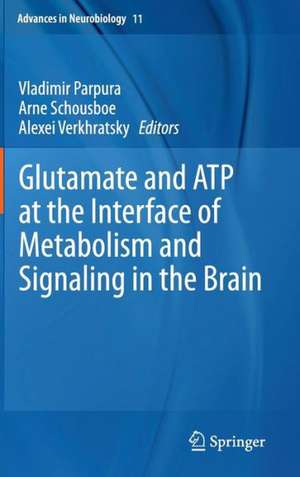Glutamate and ATP at the Interface of Metabolism and Signaling in the Brain: Advances in Neurobiology, cartea 11
Editat de Vladimir Parpura, Arne Schousboe, Alexei Verkhratskyen Limba Engleză Hardback – 30 sep 2014
In this collection of chapters, written by the leading experts in the field of cell metabolism and energetics, intracellular signaling and neurotransmission we covered various aspects of the interfacing between these two fundamental molecules. This book will be particularly useful for researchers, students, physicians and psychotherapists working in the field of neurobiology, neurology and psychiatry.
| Toate formatele și edițiile | Preț | Express |
|---|---|---|
| Paperback (1) | 639.59 lei 6-8 săpt. | |
| Springer International Publishing – 23 aug 2016 | 639.59 lei 6-8 săpt. | |
| Hardback (1) | 645.79 lei 6-8 săpt. | |
| Springer International Publishing – 30 sep 2014 | 645.79 lei 6-8 săpt. |
Din seria Advances in Neurobiology
- 18%
 Preț: 1115.14 lei
Preț: 1115.14 lei - 18%
 Preț: 1384.26 lei
Preț: 1384.26 lei - 18%
 Preț: 1385.85 lei
Preț: 1385.85 lei - 18%
 Preț: 1847.84 lei
Preț: 1847.84 lei - 18%
 Preț: 960.42 lei
Preț: 960.42 lei - 18%
 Preț: 960.93 lei
Preț: 960.93 lei - 18%
 Preț: 1229.10 lei
Preț: 1229.10 lei - 18%
 Preț: 950.33 lei
Preț: 950.33 lei - 18%
 Preț: 1671.09 lei
Preț: 1671.09 lei - 18%
 Preț: 1116.71 lei
Preț: 1116.71 lei - 18%
 Preț: 959.98 lei
Preț: 959.98 lei - 18%
 Preț: 955.08 lei
Preț: 955.08 lei - 18%
 Preț: 948.79 lei
Preț: 948.79 lei - 18%
 Preț: 1230.66 lei
Preț: 1230.66 lei - 15%
 Preț: 648.42 lei
Preț: 648.42 lei - 18%
 Preț: 1010.17 lei
Preț: 1010.17 lei - 24%
 Preț: 897.50 lei
Preț: 897.50 lei - 18%
 Preț: 964.23 lei
Preț: 964.23 lei - 18%
 Preț: 945.47 lei
Preț: 945.47 lei - 18%
 Preț: 1222.69 lei
Preț: 1222.69 lei - 15%
 Preț: 641.38 lei
Preț: 641.38 lei - 18%
 Preț: 1222.31 lei
Preț: 1222.31 lei - 18%
 Preț: 1227.21 lei
Preț: 1227.21 lei - 18%
 Preț: 1843.91 lei
Preț: 1843.91 lei - 18%
 Preț: 1231.01 lei
Preț: 1231.01 lei - 18%
 Preț: 1111.97 lei
Preț: 1111.97 lei - 24%
 Preț: 957.43 lei
Preț: 957.43 lei - 18%
 Preț: 1228.62 lei
Preț: 1228.62 lei - 18%
 Preț: 1124.47 lei
Preț: 1124.47 lei - 18%
 Preț: 1394.38 lei
Preț: 1394.38 lei - 18%
 Preț: 1227.67 lei
Preț: 1227.67 lei - 18%
 Preț: 1263.82 lei
Preț: 1263.82 lei - 5%
 Preț: 1637.00 lei
Preț: 1637.00 lei - 18%
 Preț: 948.92 lei
Preț: 948.92 lei
Preț: 645.79 lei
Preț vechi: 759.76 lei
-15% Nou
Puncte Express: 969
Preț estimativ în valută:
123.58€ • 132.14$ • 103.03£
123.58€ • 132.14$ • 103.03£
Carte tipărită la comandă
Livrare economică 18 aprilie-02 mai
Preluare comenzi: 021 569.72.76
Specificații
ISBN-13: 9783319088938
ISBN-10: 3319088939
Pagini: 261
Ilustrații: XVII, 261 p. 61 illus., 39 illus. in color.
Dimensiuni: 155 x 235 x 17 mm
Greutate: 0.57 kg
Ediția:2014
Editura: Springer International Publishing
Colecția Springer
Seria Advances in Neurobiology
Locul publicării:Cham, Switzerland
ISBN-10: 3319088939
Pagini: 261
Ilustrații: XVII, 261 p. 61 illus., 39 illus. in color.
Dimensiuni: 155 x 235 x 17 mm
Greutate: 0.57 kg
Ediția:2014
Editura: Springer International Publishing
Colecția Springer
Seria Advances in Neurobiology
Locul publicării:Cham, Switzerland
Public țintă
ResearchCuprins
1. Glutamate and ATP: The Crossroads of Signaling and Metabolism in the Brain.- 2. Glutamate Metabolism in the Brain Focusing on Astrocytes.- 3. Glycogenolysis and Purinergic Signaling.- 4. Purinergic and Glutamatergic Receptors on Astroglia.- 5. Regulated Exocytosis in Astrocytes Is as Slow as the Metabolic Availability of Gliotransmitters: Focus on Glutamate and ATP.- 6. Adenosine and Glutamate in Neuroglial Interaction: Implications for Circadian Disorders and Alcoholism.- 7. Purinergic Receptor Stimulation Decreases Ischemic Brain Damage By Energizing Astrocyte Mitochondria.- 8. Excitotoxicity and Mitochondrial Dysfunction Underlie Age-dependent Ischemic White Matter Injury.- 9. Role of Astrocytes in Delayed Neuronal Death: GLT-1 and its Novel Regulation by MicroRNAs.- 10. Ca2+ Signaling in Astrocytes and its Role in Ischemic Stroke.- 11. Pathological Potential of Astroglial Purinergic Receptors.
Textul de pe ultima copertă
ATP was naturally selected very early on as the main source of biological energy, and thus became an indispensable feature of life on the Earth. This was a critical evolutionary choice because it shaped enzymatic systems to utilize ATP in energy-dependent reactions and necessitated an appearance of the universal intracellular signaling system based on calcium ions; keeping cytosolic Ca2+ extremely low became vitally important, since otherwise insoluble Ca2+-phosphates would preclude the cell energetics. Thus, all living cells on the Earth, beginning from the most primitive ones, had high cytosolic concentrations of ATP and there is little surprise that ATP was soon utilized by nature for another fundamental function of sending information from one living cell to another. In summary, ATP acts as the main energy source and is pivotal for numerous signaling cascades both inside (by fueling various transport systems and donating phosphate groups) and between the cells (by chemical transmission). Similarly, glutamate acts as an important molecule for both intercellular signaling through glutamatergic transmission and cell energetics by contributing to ATP production.
In this collection of chapters, written by the leading experts in the fields of cell metabolism and energetics, intracellular signaling and neurotransmission, we covered various aspects of the interfacing between these two fundamental molecules. This book will be particularly useful for researchers, students, physicians and psychotherapists working in the field of neurobiology, neurology and psychiatry.
In this collection of chapters, written by the leading experts in the fields of cell metabolism and energetics, intracellular signaling and neurotransmission, we covered various aspects of the interfacing between these two fundamental molecules. This book will be particularly useful for researchers, students, physicians and psychotherapists working in the field of neurobiology, neurology and psychiatry.
Caracteristici
Suitable for advanced and graduate courses on the roles of glutamate and ATP in metabolism and signaling Only current book on this highly researched topic Contributions from leading experts in cell metabolism, intracellular signaling and neurotransmission














